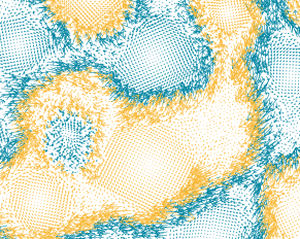25 February 2014
Spinning nanoparticles hint at origin of life
by Will Parker
 Simply making nanoparticles spin coaxes them to arrange themselves into what University of Michigan researchers call "living rotating crystals," a self-organizing behavior where the crystals take on a life of their own.
Simply making nanoparticles spin coaxes them to arrange themselves into what University of Michigan researchers call "living rotating crystals," a self-organizing behavior where the crystals take on a life of their own.
Researcher Sharon Glotzer and her team discovered the behavior while investigating methods to make nanoparticles self-assemble. They found that when they spun individual nanoparticles in a simulation - some clockwise and some counterclockwise - the particles self-assembled into an intricate architecture.
Order developing naturally from disorder is how many scientists believe life began. "One way biology approaches the challenge of assembly is by constantly feeding building blocks with energy. So, that's what we did with nanoparticles," explained Glotzer. "If we can understand that, not only can we begin to imagine new ways to make materials and devices, but also we may begin to understand how the first living structures emerged from a soup of chemicals."
The team's simulation can be imagined as two sets of pinwheels on an air hockey table. The air pushing up from the table drives some of the pinwheels clockwise, and others counterclockwise. When the pinwheels are tightly packed enough that their blades catch on one another, the team found that they begin to divide themselves into clockwise and counter-clockwise spinners - a self-organizing behavior known as phase separation. "They organize themselves," said research team member Daphne Klotsa. "They developed collective dynamics that we couldn't have foreseen. The important finding here is that we get phase separation without real attraction."
The team, reporting their findings in Physical Review Letters, say the self-sorting is counterintuitive because no direct forces push the same-spin pinwheels together or push opposite-spinners apart. The separation occurs because of the way the pinwheel blades collide. While a pair of pinwheels may be spinning in the same direction, where their blades might meet, they're actually moving in opposite directions. This means that the blades will push into one another and stick together, causing the pair of pinwheels to rotate as one, at least briefly.
In contrast, the blades of opposite spinners are moving in the same direction where they meet, so they don't stick together. Since same-spinning pinwheels spend more time linked up, they gradually accumulate into groups.
When the pinwheels divide into clockwise and counterclockwise tribes, the boundary between the groups becomes a thoroughfare for particles in the mix that aren't spinning. The blades at the boundary push these non-spinning particles along the border, making them less likely to dive back into the denser collections of pinwheels.
While the computer simulations were in two dimensions, as though on a flat surface, the team anticipates that rotating particles could also grow into "living," three-dimensional crystals.
Related:
Discuss this article in our forum
Knocking on the door of life: Self-replicating RNA synthesized
Rethink creation of life in terms of information, argues new theory
Nomad planets seeding life throughout the universe?
Volcanic Clay May Have Served As Womb For Emergent Life
Source: University of Michigan
